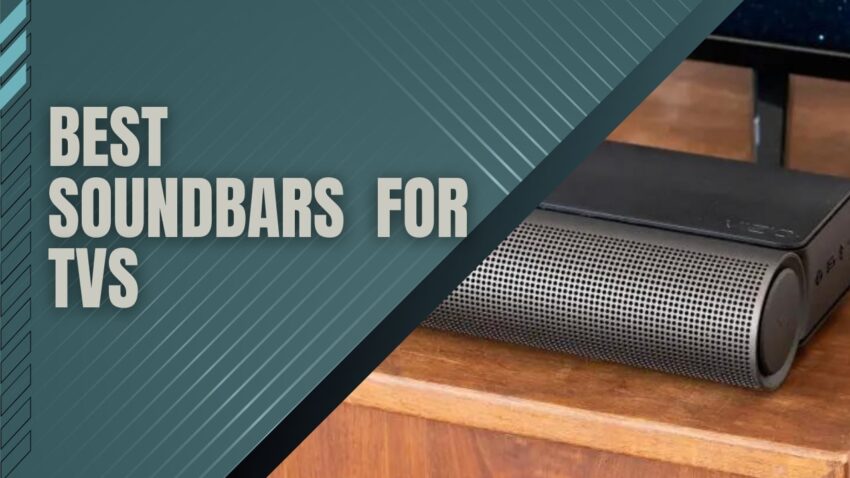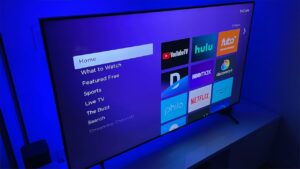It is important to have the soundbars for TV to get better-sounding performance. When compared to the home theater, soundbars deliver a few benefits: they generally occupy less space and are easier to set up and are affordable.
Whether you’re looking for a smart soundbar that supports Dolby Atmos, there are many models out there that’ll do what you need. However, not all soundbar has the same quality and features, some offer a better experience of sounding and listening.
When you watch more TV shows, sports, or listen to music often at home, you’ll need something that sounds good and is compatible with your existing devices. Don’t compromise with the built-in speakers of your smart TV. Investing the money to the best soundbars for TV will carry your TV shows, films, and games to get better-sounding performance.
Below is the list of best soundbars for TV that you can buy in 2024. I have reviewed 8 best products from amazon, check it out and pick one that best suits you.
Also interested in the best 4k TVs which produces Better Sound effects Click Here
Our Top Picks of Soundbars for TV
1. Samsung HW-Q90R
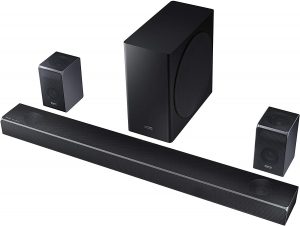
Available on Amazon
The Samsung HW-Q90R is the best soundbars for TV you can buy in 2024. It comes with a portable subwoofer and two dedicated satellite speakers to enable you to completely involve yourself in your favorite movies or video games.
It has several connectivity options, including 2 full HDMI-in and 1 HDMI ARC port, allowing you to set it up as a hub between your smart TV, gaming console, and cable box. It also feels very well-built and looks attractive.
This is the best soundbar to buy which makes a great deal not only for watching movies and TV shows but also for listening to music as well. This contains lots of sound profile features without losing dialog or vocals, so it is the best soundbars suited for action movies.
It supports most home theatre systems and is one of the best Dolby Atmos soundbars. This soundbar performs best when it comes to Dolby Atmos content like films, but it will still not sound as natural.
- Great audio reproduction.
- Multiple connection options.
- Great performance at high volume.
- Supports Atmos and height channels for an immersive experience.
- Small interface screen.
- Very wide soundbar.
- No room correction.
2. VIZIO SB36512-F6
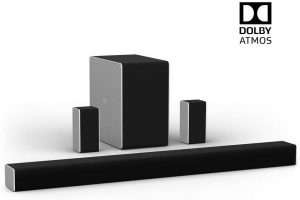
Available on Amazon
If your thinking to buy the best soundbars for your budget then I surely recommend you to take Vizio F6. It does not have an attractive design like the Samsung HW-Q90R but it provides the best quality of sound effects for its price. It comes with a wireless subwoofer that is perfect for films, sports, and bass-heavy songs, offering great bass quality with deep thump and rumble.
The Vizio SB36512-F6 is an excellent setup for the 5.1.2 soundbar. Due to up-firing speakers and assistance from Dolby Atmos, it provides an enjoyable audio experience. The audio quality is pretty good, with a positive sound profile. The soundbars can get loud enough for all content types.
- Great stereo performance.
- Decent soundstage.
- Atmos support.
- Amazing connectivity options.
- No Dialog Enhancement feature.
- Soundbar speakers need to be wired to the wireless sub.
3. Samsung HW-Q80R
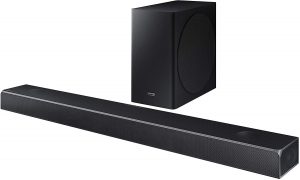
Available on Amazon
The best 5.1 soundbar system we’ve reviewed so far is the Samsung HW-Q80R. It does not come with satellite speakers, provided in the Samsung Q90R but performs well.
The design quality of this model is similar to the Samsung Q90R where it has some great design and lots of connectivity options at a low price. It also supports Dolby Atmos content. The sound coming from the Samsung Q80R is excellent, accurate, well balanced and also very clear even at the higher volume.
This soundbar shares the other Samsung’s equal balanced sound profile, which is fantastic. Without compressing, it can get very loud and even have a built-in EQ.
The design is well-constructed and looks high-end model, but there are no rear speakers like Samsung HW-Q90R has. However, if you’re in search of a great 5.1 soundbar setup with a separate subwoofer, this is the best choice.
- Great audio reproduction.
- Multiple connection options.
- Great performance at high volume.
- Supports Atmos and height channels for the best experience.
- Small interface screen.
- No room correction.
4. Sonos Beam

Available on Amazon
The best small soundbar we’ve reviewed so far is the Sonos Beam. It’s more durable when compared to the other small soundbars. You can buy a separate subwoofer or satellite speaker if you want to get a better performance in sound or if you want to expand your setup. It has tons of features for sound enhancement, including room correction, and overall feels like a premium product.
Sonos Beam is the good soundbar, it has great room correction features and setup that helps to adjust the audio delivery depending on your room. If you watch more TV shows this model is a good choice and its overall audio quality is good. It’s also very easy to setup configurations and improves performance.
- Very well-built design.
- A well-balanced sound profile.
- Great center channel performance for dialogue in movies.
- Easily upgradable setup.
- Lacks sub-bass.
- No DTS support.
- No Full HDMI In ports.
5. BOSE SOLO 5
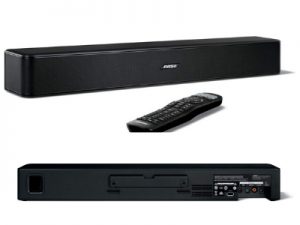
Available on Amazon
If you’re looking for a small soundbar with an easier setup and play model, get the Bose Solo 5. It does not have any modern inputs such as HDMI ports and lacks the special features to improve the listening experience like the Sonos Beam. When it comes to stereo audio, the Bose Solo 5 is a nice quality soundbar, but it won’t be great for a true surround sound experience.
It supports Bluetooth connectivity on the upside and has an AUX port, so it’s much easier to set up the device with this soundbar. The soundbar performance is disappointing when compared with the Sonas beam soundbar. This model does not provide access to the EQ or room correction feature to support sound quality.
- Well-built design.
- Decent sounding on stereo content, especially for its size
- Lack of DTS support; poor connectivity options.
- Poor bass performance.
- Small soundstage.
6. Yamaha YAS-207
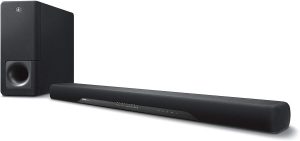
Available on Amazon
Yamaha YAS-207 is the best soundbar for TV that can be affordable and its a budget-friendly soundbar. The audio delivery from this soundbar is decent when compared to the price range. This soundbar has many connectivity options and also has a few settings that can really improve the overall sound quality and performance.
This soundbar has a very well-balanced frequency response that is suitable for TV shows and music. The bass doesn’t get as deep as other soundbars, but it still gives a better sounding. It does not support Dolby Atmos, but through an HDMI connection, you can enjoy Dolby Digital or DTS content.
- Neutral sound signature.
- Decent build quality.
- Good overall stereo performance.
- Lacks sub-bass.
7. SONY HT-S100F
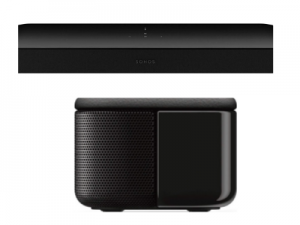
Available on Amazon
If you’re searching for something even cheaper, get the Sony HT-S100F. It sounds less when compared to Yamaha YAS-207, but it is affordable at a low price compared to Yamaha YAS-207. If you want the best soundbar for a TV without spending a lot of money then this model is the best choice. it doesn’t come with a subwoofer but performs well.
This is well suitable for TV shows because it has a dialogue enhancing feature. Its connectivity options are quite limited and it only supports Dolby Digital. if you’re looking for the best soundbars for a TV without spending too much money, then SONY HT-S100F is the best choice.
- Great for dialog content.
- Gets loud enough for most uses.
- Performs well at max volume.
- Lacks bass.
- It doesn’t support DTS.
- Always-On surround sound feature.
8. Bose Soundbar 700
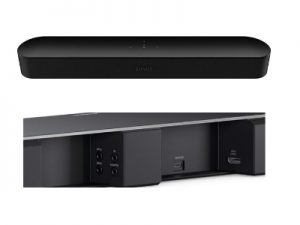
Available on Amazon
A Bose Soundbar 700 is a decent 3.0 soundbar. Due to a stronger frequency response and a more positive sound profile, it works better than the Bose Soundbar 500. This soundbar also features side-firing speakers that echo the sounds, offering you an impressive sound quality.
For most purposes, it also gets loud enough and doesn’t compress at max volume, which is perfect. The audio performance in the bose soundbar 700 is better. And the price range is also low and can afford at the best value.
The soundbar is built-in voice assistants, like Alexa and the Google Assistant, with superior voice pickup.
- Very well-built design.
- Decent audio reproduction.
- Easily upgradable setup.
- Lacks sub-bass.
- Lacks Full HDMI In ports.
How to choose the best TV soundbar for you
When selecting a TV soundbar, there are several things to keep in mind. To begin, determine the size of your TV to determine the appropriate soundbar dimensions. You don’t want a soundbar that is too small or too big for your TV. Additionally, consider the height and placement of your soundbar, as obstructing your TV picture or ceiling can cause issues. Soundbars are generally one long speaker with several drivers inside, but some come with external subwoofers and rear speakers for surround sound effects.
Features and connectivity are also important factors to consider when choosing a soundbar. Many modern soundbars come with ARC and eARC-enabled HDMI ports and optical inputs for older TVs, allowing you to control the soundbar’s volume with your TV remote. You should also consider whether you want to control your soundbar through a separate physical remote or smartphone app. Many soundbars support wireless music playback via wifi streaming services like Airplay 2, Spotify Connect, and Chromecast, as well as Bluetooth connectivity.
If you’re looking for a soundbar that produces an immersive home cinema experience, pay attention to models that can handle Dolby Atmos and DTS:X audio. Some soundbars use virtual processing, while others have up-firing speakers for height effects. Keep in mind that the result will be more effective if you have low ceilings to bounce sound off and if the top of the soundbar is uncovered and clear of the TV screen.
If high-quality 3D sound is important to you, make sure your TV and potential soundbar support Dolby TrueHD and eARC. The ARC standard can handle Dolby Atmos, but only in its Dolby Digital Plus form, which is lossy. Dolby TrueHD, on the other hand, can deliver full-fat Dolby Atmos in all its lossless glory.
Finally, consider the content you’ll be viewing and the sources you’ll be plugging in. If you are just watching Freeview, many of these technologies will be redundant. But if you’re streaming content like Netflix, Apple TV, and Amazon Prime Video in 4K HDR, you’ll want to make sure your sound quality is top-notch. For more information, check out our comprehensive guide on selecting and setting up a soundbar.
FAQ
Can you add a soundbar to any TV?
Yes, you can add a soundbar to any TV that has an audio output. Almost every soundbar and TV, regardless of its age, will have an optical connection that can be used to connect the two. In addition, many modern TVs also have ARC (Audio Return Channel) or eARC (Enhanced Audio Return Channel) HDMI ports that can handle high bandwidth multichannel audio formats, allowing for a more advanced audio experience. It’s important to check the compatibility of your TV and soundbar and ensure that you have the appropriate cable, which is often included in the box with your soundbar.
Which is better for a soundbar: ARC or Optical?
Optical connections are limited in bandwidth compared to ARC/eARC connections. So, if you have the choice, and opt for optical, you might not get the most out of the audio decoding built into your soundbar. Optical can handle compressed Dolby Digital or DTS 5.1 surround sound, but it can’t handle advanced immersive formats like Dolby Atmos or DTS:X.
ARC/eARC is a better option, but you need to ensure that your TV has a compatible HDMI socket that supports all the audio formats being sent to your TV. ARC supports Dolby Atmos in its lossy Dolby Digital Plus format, while eARC can handle high-quality codecs such as Dolby Atmos in Dolby TrueHD, DTS-HD Master Audio, or DTS:X. If you are viewing or gaming involves physical media, you will probably want to ensure you have got an eARC connection to get the most from your system.
ARC/eARC also allows you to control the basic volume and power functions of your soundbar with your main TV remote via HDMI CEC. Some soundbars come with their own remotes and/or have app control. If your connection to your TV uses an optical cable, you may still be able to use your regular controller. Certain models, such as the Sonos Ray and B&W Panorama 3, can ‘learn’ to recognize the commands of both IR and RF remotes, but this depends on your TV manufacturer.
However, ARC/eARC can sometimes introduce a slight audio lag resulting in lipsynching issues that can vary depending on your TV-soundbar combo. Many brands include controls to adjust the delay on a soundbar’s app, and sometimes there’s also an option to modify it on a TV’s settings.
If you are using ARC/eARC to connect to a Dolby Atmos soundbar, check whether you are actually receiving Atmos. Most soundbar apps will give you confirmation of the type of audio format that you are currently listening to on the Now Playing page or occasionally on the soundbar’s display (if it has one). So if what you are playing should be in Dolby Atmos, but the app says otherwise (likely ‘PCM’, ‘5.1’ or ‘2.0’), then it’s time to delve into the settings of your TV and Blu-ray player.
To receive Dolby Atmos, any source device must be set to output bitstream audio. You can find this option in the audio settings of TVs, Blu-ray players, and streaming sticks. In PCM, you will hear the audio only in stereo, but sending bitstream means your soundbar will be able to receive those lovely Dolby formats, including Atmos.
What are the best equaliser setting for a soundbar?
If your soundbar comes with its own automatic calibration software, make sure you run it, so the soundbar’s audio output is matched to your room’s layout and characteristics. The Sonos Arc, for example, uses Sonos’s Trueplay software in conjunction with your smartphone’s microphone to tailor its sound.
Although automated optimization is great, your own ears are even better. If your soundbar also has options to alter individual channel levels, don’t be afraid to tweak things to suit your taste and needs. Every room is different, and hearing is subjective, so what sounds great to one person may not to another. The great thing about a soundbar is that it is generally straightforward to make adjustments and swap back if you change your mind.
Some soundbars come with pre-programmed modes for different types of content. In our experience, soundbars with cinematic modes often use ‘spatial’ processing that can introduce high-frequency artefacts. In contrast, ‘music’ modes will usually have a bass and treble-heavy EQ that can sound a little brash. We tend to prefer a flat standard mode, if one is available, that we manually adjust to our liking. But there is no one-size-fits-all approach that will work for every room and listener.
There is little more frustrating than not being able to hear dialogue when watching a TV show or movie. Inevitably, varying levels of speech clarity combined with how busy the soundscape is and the overall style of the mix can mean that whispery, mumbly vocals hinder even a top-quality, room-tuned soundbar.
Fortunately, most soundbars have speech enhancement feature settings that will typically raise the volume of the centre channel and crisp up the EQ to help improve dialogue audibility. Not every brand implements this with sophistication, and sometimes these modes can sound thin and harsh, but once again, it’s always worth experimenting to find what works for you and your space.
Conclusion
The above listed are the best soundbars for TV that are currently most people buy. We have analyzed the features and functions of each product and reviewed our best for the buyers. The soundbar completes your sound system. I hope this article helped you to choose the best soundbars for TV based on your requirements.
Take a look at these products from the same price range, that are available right now on Amazon:
Related Posts:
- LG C8 OLED TV 2024 - Impressive HDR Gaming Performance
- Input Lag Explained - Demystifying and Unlocking…
- 12 Best Budget Soundbars 2024 - Elevate Your Audio…
- 10 Best Soundbars for LG TV 2024 - Ultimate Audio…
- Ultimate Guide to Get Better Viewing Angle Explained…
- Best TV Settings For Gaming - Get Better Experience


